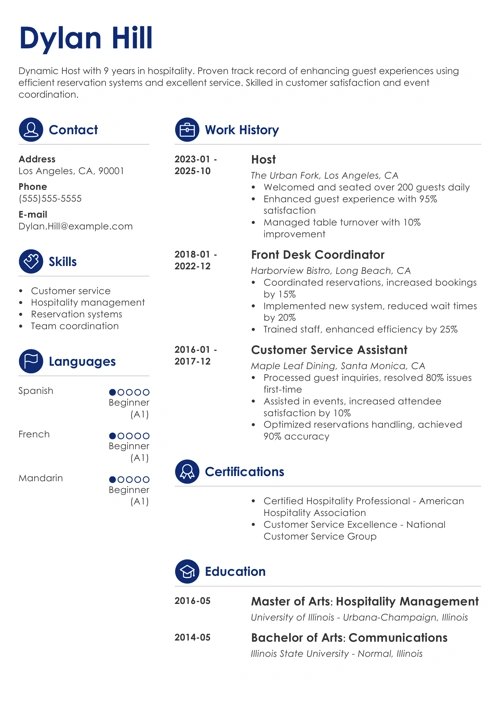For most people, there’s only one thing worse than writing a resume—writing a cover letter.
It’s not hard to understand why—it needs to be professional, include your work experience and skills, and compel the employer to give you a call.
That’s a pretty tall order.
But that becomes a whole lot easier when you break the cover letter down into its essential elements and understand the purpose of each part of the cover letter.
This guide will show you the right cover letter structure in no time.
Want to write your cover letter fast? Use our cover letter builder. Choose from 20+ professional cover letter templates that match your resume. See actionable examples and get expert tips along the way.
Sample Cover Letter for a Resume—See more cover letter templates and create your cover letter here.
Looking for a full guide on cover letter writing? See: How to Make a Cover Letter
Here are the key parts of a cover letter:
- Cover letter header
- Cover letter salutation
- Cover letter body
- Cover letter closing
Let’s dive right into the elements of a good cover letter structure!
1. Parts of a Cover Letter: Example
Wesley Lopez
Front-End Developer
123 Spring Lane
Nashua, NH, 03060
123-456-7890
wesley.lopez@email.com
linkedin.com/in/wesley.lopez
Nashua, NH, March 15, 2023
Margaret Hill
Human Resources Manager
Blaze Tech
456 Innovation Drive
San Francisco, CA, 94105
Dear Ms. Hill,
I am writing to express my interest in the Front-End Developer position at Blaze Tech. With my three years of experience as a front-end developer at Link Tech, I bring a unique mix of expertise, problem-solving skills, and precision that could significantly contribute to Blaze Tech's mission of delivering high-quality tech solutions.
In my previous role at Link Tech, I led a team that worked on an ambitious project to redesign our main client's website. The result was a 20% increase in site traffic and a 15% increase in user retention. I am particularly proud of this accomplishment as it shows my ability to deliver tangible user engagement and customer satisfaction results.
What motivates me about joining Blaze Tech is your reputation for fostering innovation and creative problem-solving. I am particularly drawn to the culture of continuous learning and growth that Blaze Tech promotes. I am eager to contribute my front-end expertise while expanding my knowledge of back-end technologies.
My proficiency in JavaScript, HTML, CSS, and React and my experience in team leadership and client relationship management will positively impact Blaze Tech. Blaze Tech's values align with my drive for constant self-improvement and dedication to quality.
I would greatly appreciate discussing how my skills and experience could benefit Blaze Tech in a meeting. Please feel free to contact me at your earliest convenience. I look forward to contributing to Blaze Tech.
Kind Regards,
Wesley Lopez
2. Cover Letter Header
The cover letter header is one of the first parts of a cover letter that the hiring manager sees so you need to get it right if you don’t want your cover letter to tank.
Thankfully, it’s pretty straightforward.
Add your name, address, current phone number, and email address. If you’ve done some LinkedIn optimization, feel free to add your profile here too. After that add the date and place.
Further down add the contact information of the employer that you’re applying to. This should include the hiring manager’s name, title, and company address.
Pro Tip: Keep it professional—no emails like “fancypants77@yahoo.com”. Also make sure that the contact information in your cover letter header matches that in your resume.
Read more: How to Address a Cover Letter
3. Cover Letter Salutation
Out of all the elements of a cover letter, this one is usually the most overlooked.
Why? It looks like a sinch, but mess it up and you’re done for.
Start off this cover letter section with a professional greeting, preferably include the name of the employer.
“To Whom It May Concern” or “Dear Sir or Madam” should be avoided. They make you sound generic and like you don’t give a flying squirrel about the job.
Try to find the hiring manager’s name in the job ad or by doing an internet search.
Read more: What to Write Instead of "To Whom It May Concern” in a Cover Letter
4. Cover Letter Body
This part of your cover letter actually consists of three smaller parts, each with its own specific purpose. Let’s break it down now.
Cover Letter—First Paragraph (“The hook”)
As the nickname suggests, this component of your cover letter is intended to hook the hiring manager’s attention and reel it right in.
Don’t start off with the fact that you’re applying for the open job position—they already know that.
Use your cover letter introduction to showcase a couple of big achievements or rich experience that will impress the recruiter to continue reading. Mention that you want to use your experience and skills to help drive the company forward or solve its problems.
Cover Letter—Second Paragraph (“Make an Offer”)
This is the most difficult of the cover letter components. But that doesn’t mean it’s impossible, so don’t dramatically fling yourself on your bed just yet.
Use the job ad as a cheat sheet and explain how your skills and experience can benefit them. For example, are they looking for an experienced, friendly retail sales associate? Tell them how you’ve been in that role for the last 3 years, consistently maintaining a 95% customer satisfaction rate.
Getting my drift?
Use moderation when talking about your professional achievements. Nobody likes a windbag.
Add bullet points and numbers to make your offer really stand out. Avoid overly long sentences and blocks of text. This isn’t an essay writing contest.
Cover Letter—Third Paragraph (“Call to Action”)
Use this part of your cover letter to make the recruiter realize that they do want to call you.
Reiterate your interest in the job and how you believe that you would be a great fit for the company. Ask for a call or meeting to discuss your fit to the team and the benefit for the company.
These three parts of your cover letter put together constitute the main body structure.You shouldn’t just copy what’s on your resume, but make sure that what you’re writing in your cover letter compliments your resume and vice versa.
Read more: What a Cover Letter Should Say
5. Cover Letter Closing
This is the part of the cover letter where you thank the hiring manager for their time.
Use a professional sign off such as “sincerely” or “kind regards”. Avoid closings that are too informal such as “cheers” or “thanks”.
Type out your full name. Leave some space below to either sign your name if you have a printed cover letter or for an electronic signature if you’re sending your cover letter by email.
Don’t forget about your cover letter enclosure at the very end. It’s especially helpful if the hiring manager requires several different documents in your job application.
After analyzing 11 million resumes made with our builder, we noticed that these are the top 10 professions that usually create a cover letter:
- Business Operation Specialists
- Top Executives
- Advertising, Marketing, and PR Managers
- Clerks
- Engineers
- Retail & Sales Representatives
- Healthcare Practitioners
- Financial Specialists
- Teachers and Instructors
- Counselors, Social Workers, and Social Service Specialists
Creating a resume with our builder is incredibly simple. Choose a resume template and follow our step-by-step guidance to have a professional resume ready in minutes.
When you’re done, our AI resume builder will score your resume and our resume scanner will show you exactly how to improve it.
6. Cover Letter Format
It doesn’t really matter what you write and how many cover letters you send out— if they look like they’ve been pulled out of dog’s throat, no employer is going to call.
Make sure that your cover letter format is just as professional looking as your resume format.
Use a modern cover letter font and plenty of white space to make your cover letter easy to read for the employer. Make sure you also adjust your cover letter margins and the text body.
Also don’t ramble on for pages and pages. Most cover letters are one page in length.
Read more: The Best Cover Letter Layout
Key Takeaway
Hopefully now you know what exactly a cover letter consists of and which parts of a cover letter go where.
Remember, the right cover letter structure consists of:
- Cover letter header
- Cover letter salutation
- Cover letter body which includes the first, second, and third paragraphs
- Cover letter closing
And that’s it! Those are the key elements of a cover letter.
About Zety’s Editorial Process
This article has been reviewed by our editorial team to make sure it follows Zety's editorial guidelines. We’re committed to sharing our expertise and giving you trustworthy career advice tailored to your needs. High-quality content is what brings over 40 million readers to our site every year. But we don't stop there. Our team conducts original research to understand the job market better, and we pride ourselves on being quoted by top universities and prime media outlets from around the world.



